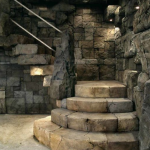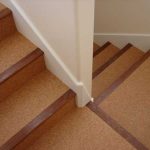The finishing of a concrete staircase in a private house is necessarily carried out at the final stage of the construction of the building, since the appearance of reinforced concrete products leaves much to be desired. There are many options for solving this issue, the main thing is to finish the concrete staircase so that it organically fits into the interior, is convenient and safe to use.
Features of the concrete structure
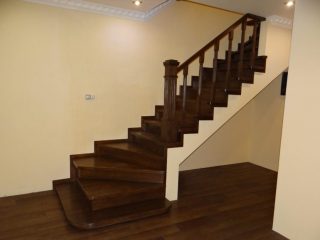
Most often, concrete stairs are installed in basements or as part of a high porch. Often, a decision is made to use them inside spacious buildings, including as interior elements. The structures are distinguished by high bearing capacity, moisture resistance, practically unlimited service life.
It is necessary to take into account the negative aspects of the issue: high cost, duration of construction and a rather gloomy appearance. The first two factors are objective and cannot be influenced. The third is successfully eliminated by an optimal approach to finishing the concrete steps and the side of the structure.
Requirements when choosing a finishing material
Decorating stair steps in a private house is a procedure that is both creative and scientific. Any engineering structure must meet certain technical and aesthetic requirements:
- presentable appearance;
- compliance with the interior;
- stability;
- safety of movement;
- wear resistance;
- environmental Safety;
- maintainability;
- ease of cleaning and maintenance;
- durability;
- immunity to mold and mildew.
Choosing the right material is not particularly difficult. There is an extensive range of products on the construction market, the characteristics of which meet all of the listed requirements.
Concrete staircase finishes
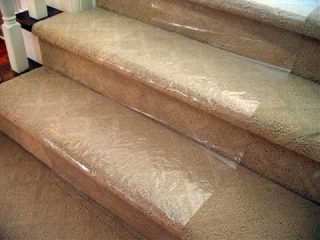
To make a flight of stairs beautiful, practical and safe, there is a wide range of materials that differ in structure and composition. They can be hard and soft, liquid and solid, from natural and synthetic raw materials.
The most common types of cladding are:
- Paint. It is more often used to decorate structures located on the street and in utility rooms. Inside the house, the concrete stairs are first plastered and then polished.
- Carpet covering. The finish is soft, flexible and pleasant to the touch. Fastening is carried out using removable needles. The downside is that the treadmill needs to be cleaned frequently and periodically removed for washing.
- Linoleum. Inexpensive but impractical solution. At the folds, the stripes form semicircular transitions, which greatly spoil the picture. If pasting is carried out, laborious installation of corner profiles will be required.
- Laminate or parquet board. Glued panels are distinguished by their spectacular appearance, strength, durability and wear resistance. Fastening can be carried out on glue or frame. Attention is drawn to the sealing and sealing of the edges of the boards.
- Ceramic tiles or porcelain stoneware. For a walk-through structure, floor tile models or porcelain stoneware of the same internal composition are used. The sides of the steps can be tiled by choosing a contrasting color with them.
- A natural stone. The coating is beautiful, looks luxurious, resistant to all possible factors.However, natural material has an impressive cost and is very difficult to process with household tools.
- Wood. This type of finish has a lot of positive characteristics. Looks good in any interior, easy to handle, warm to the touch, easy to decorate. The structure should be sheathed with hardwood boards, pretreated with an antiseptic and hydrophobic impregnation.
- Cork covering. Natural material with high thermal insulation properties and the ability to absorb footsteps. A high-quality coating is resistant to wear, does not absorb water, and does not need additional processing. Fixed with glue on the steps.
- Polished concrete as solid and finish at the same time. Such a surface looks good if the pouring was carried out using white cement, plasticizers and crushed granite. In this case, polishing exposes and reveals all the beauty and depth of decorative concrete. If the classic version was used, the wet sanding method with the addition of dyes is used.
There are enough options for finishing a reinforced concrete structure to satisfy any taste and aesthetic preferences.
DIY finishing technology

The technology of facing concrete stairs is standard only for the preparatory stage. In the future, each material uses its own fastening methods. This provision also applies to the list of tools that will be required for the installation of the finishing cladding.
The preliminary phase includes the following activities:
- Measurements. The compliance of the geometry of the structure with the design data is checked. If necessary, the staircase is leveled in space, the curvature of the surfaces is eliminated with cement mortar.
- Elimination of detected defects. Sinks, caverns, holes and cracks are cleaned of debris and then sealed with mortar or sealant flush with the base.
- Strengthening surfaces and increasing adhesion. First, the steps and sides are treated with a deep penetration primer. After drying, a “contact-concrete” agent is applied, which ensures reliable adhesion to any formulations.
The following technologies are used to apply the topcoat:
- Ceramic tiles, laminates, cork, parquet boards and natural stone are glued directly to the concrete. For fixing, a mixture is used that corresponds to the composition of the lining. Panel joints are sealed with end and corner profiles.
- When choosing solid wood as a flooring, the boards are laid on waterproof plywood screwed to the steps.
- If a roll of thick fabric is used, it is held tightly to the base by means of pressure elements - metal rods and rings.
When purchasing material, it is recommended to make a stock within 15% to cover its damage during installation, storage and transportation.
Important nuances
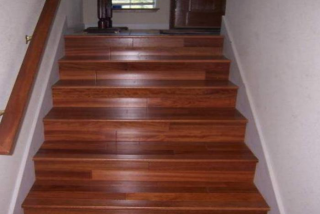
When choosing a material and a method of laying it, the masters recommend taking into account a number of the following points:
- The steps should be well aligned. On an uneven surface, the coating will squeak and wobble.
- If a tree is chosen, you need to buy the strongest species - ash, cedar, beech, oak.
- Laminate should be taken commercial, with maximum strength and durability.
Do not use more than 2-3 colors, otherwise the design will look variegated and tasteless.
Original design solutions
Overhead lamps, wood, metal and polycarbonate inserts look spectacular on the steps. If profiles are used, it is better to dwell on copper or brass products, which look expensive and presentable when polished.
Depending on the interior of the premises, art deco, pop art, high-tech, neoclassicism, Scandinavian, classic, provence and techno styles are used. Strict geometric lines, smooth transitions, complex and simple patterns are possible.
In some cases, minimalism will be the best solution, if you do not plan to make the staircase the main element of the interior of the house. You can diversify the picture with original objects installed on the sides of the span.

